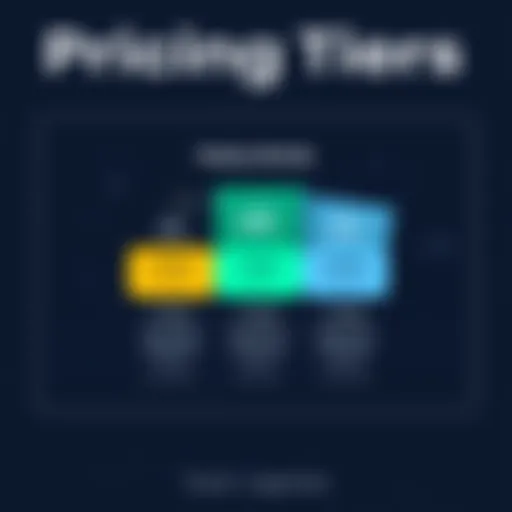Exploring the MongoDB Cloud Free Tier: Features and Benefits


Intro
In today's fast-paced digital landscape, small to medium-sized businesses and entrepreneurs often seek efficient, scalable database solutions without breaking the bank. This is where MongoDB Cloud Free Tier shines. With its distinct features and user-friendly interface, this service allows users to build and manage their applications seamlessly while keeping operational costs minimal. But what makes this cloud offering stand out? Let's dive into its key features and unique selling points.
Key Features of the Software
Overview of Core Functionalities
MongoDB Cloud Free Tier provides users access to a host of essential functionalities that cater particularly well to startups and individual developers. Some of its foundational features include:
- Document-based data model: Unlike traditional relational databases that store data in tables, MongoDB utilizes a flexible schema, allowing for varied data types. This means developers can iterate quickly without worrying about rigid structures.
- Scalability and performance: Users can scale their databases effortlessly with options for horizontal scaling. Whether you're experiencing a surge in traffic or retaining consistent load, MongoDB adjusts smoothly.
- Built-in security features: The free tier includes robust security protocols such as data encryption, ensuring sensitive information remains safeguarded. This is particularly vital for businesses dealing with customer data.
Unique Selling Points
- No Cost Access: The MongoDB Cloud Free Tier eliminates the cost barrier, making it accessible to startups and developers who may not yet have a budget for database services.
- Real-Time Data Access: The platform’s capability to provide real-time data access allows businesses to make timely, data-driven decisions, enhancing operational agility.
- User-Friendly Interface: For a database management system, MongoDB maintains a surprisingly approachable interface designed for ease of use. Its dashboard is intuitive, enabling users to launch applications without extensive database knowledge.
"MongoDB Cloud Free Tier is a practical solution for those testing the waters of cloud databases, offering enough features to explore while staying within budget."
In-Depth Software Analysis
Pros and Cons
Delving deeper into MongoDB Cloud Free Tier, it's crucial to assess its advantages and drawbacks:
Pros:
- Flexible Schema Design: Allows developers to mold the database to their needs rather than fitting their applications to the database.
- Community Support: An active forum and community of developers provide a wealth of resources.
Cons:
- Limitations on Storage and Operations: As with any free tier, there are caps on data usage and connections, which might restrict more extensive projects.
- Learning Curve for Complex Queries: Although the basic functionalities are easy, learning the nuances of complex queries may take some time.
Performance Metrics
When considering the performance of the MongoDB Cloud Free Tier, it's essential to note how it measures up against other cloud database services:
- Response Time: Most users report favorable response times under average loads, though spikes may lead to throttling.
- Uptime Reliability: MongoDB's infrastructure generally offers excellent uptime, though the free tier may not guarantee the same levels as their paid options.
Overview of MongoDB Cloud Free Tier
When it comes to modern web applications and data management, MongoDB stands tall with its innovative NoSQL database solutions. This overview will shed light on the MongoDB Cloud Free Tier, a resourceful option designed for individuals and small enterprises. Understanding this tier is essential for anyone venturing into cloud databases or considering moving their projects into a more scalable environment.
Prelude to MongoDB
MongoDB is more than just a database; it's a versatile platform that allows developers to build applications rapidly while managing data efficiently. At its core, it offers a flexible document model, making it adept at handling various data types. Unlike traditional relational databases which structure data in rigid tables, MongoDB embraces a more dynamic approach, accommodating changes in data structure without the hassles of schema migrations.
But where does MongoDB fit in the cloud? With the increasing demand for cloud solutions, MongoDB has made its way into the cloud, offering robust services that cater to diverse business needs. Whether you're building small prototypes or large-scale applications, understanding how MongoDB Cloud operates can change the game.
What is the Cloud Free Tier?
The Cloud Free Tier is a no-cost entry point for developers and small businesses to use MongoDB's cloud services. Imagine having access to powerful cloud-based features without the hefty price tag! This tier allows users to explore the capabilities of MongoDB Atlas—a fully managed cloud service—for free, albeit with certain limitations.
Here’s what you can expect from the Cloud Free Tier:
- Resource Accessibility: You get a free database cluster with limited resources, enough for experimentation and small projects.
- Easy Setup: The onboarding process is straightforward. Even those who aren’t tech-savvy can easily navigate through it, thanks to user-friendly interfaces.
- Scalability: Even within the free tier, users can test the waters of MongoDB Atlas and easily upgrade as project needs change.
"MongoDB Cloud Free Tier is like dipping your toes in the pool before diving in; it lets you feel the water without the commitment."
While the free tier offers an excellent introduction, it's essential to be aware of the limitations it presents. We'll dive deeper into these topics in subsequent sections, focusing on the core features, benefits, and best practices to maximize your experience. Understanding the Cloud Free Tier serves not just as an entry point but as a strategic step toward leveraging the full potential of cloud databases.
Core Features of MongoDB Cloud Free Tier
The Core Features of the MongoDB Cloud Free Tier stand as a testament to its robust capabilities, making it an optimal choice for small to medium-sized businesses and entrepreneurs looking to harness the potential of cloud databases without substantial financial commitments. This section delves into the essential elements, from database management to security measures, enriching the understanding for IT professionals and business decision-makers alike.
Database Features
At the heart of MongoDB Cloud Free Tier lies its database architecture, a non-relational model that allows for flexible data storage and retrieval. Unlike traditional databases, MongoDB uses documents in a BSON format, which is like JSON but is more efficient in terms of storage and querying.
- Flexible Schema: One big advantage here is the dynamic schema. Developers are freed from the constraints of planning the entire database structure ahead of time. They can iterate and adapt the schema as the application evolves. This is particularly beneficial in fast-paced environments where requirements seem to shift at the drop of a hat.
- Scalable Performance: The free tier allows users to scale databases up to a certain limit, accommodating growth without needing to switch platforms. This can be crucial for startups eager to upscale without a major overhaul. Users can also take advantage of MongoDB's sharding, a method that spreads out data across multiple servers, facilitating faster queries and improved performance under pressure.
- Rich Query Language: MongoDB's query language supports a multitude of CRUD operations, allowing for sophisticated queries and aggregations. The aggregation framework is powerful and intuitive, making it easier for developers to compute results directly from the database.
Security Attributes
When it comes to data security, MongoDB Cloud Free Tier does not cut corners, providing a suite of security features to protect valuable information. A secure database is a must-have in today’s landscape, where cyber threats are more prevalent than ever.
- Data Encryption: Both at rest and in transit, data is encrypted, ensuring that sensitive information remains confidential. This is particularly important for businesses handling personal identification datas, like healthcare information or financial records.
- Access Control: MongoDB implements role-based access controls, which means that administrators can specify who has access to different sets of data. This granularity helps prevent unauthorized users from accessing critical information.
- Network Security: Through Virtual Private Cloud (VPC) peering and IP whitelist features, users can restrict database access to only specific IP addresses. This additional layer of security is vital for small businesses that need to safeguard their data against external threats.


Backup and Restore Capabilities
Data loss can be catastrophic, and MongoDB is well aware of this fact. The Free Tier comes with comprehensive backup and restore capabilities, ensuring peace of mind for users.
- Automated Backups: The automatic backup feature ensures that data is regularly saved, reducing the risk of loss from accidental deletions or other mishaps. These snapshots can be scheduled, allowing for flexible recovery options.
- Point-in-Time Recovery: In case of an unfortunate mishap, users can restore their database back to a specific time, which is a lifesaver for any project experiencing unexpected issues. This function echoes the importance of maintaining data integrity and reliability.
"Backups are not an option, they’re a necessity in today’s digital age."
In summary, the core features of the MongoDB Cloud Free Tier furnish its users with a solid framework for data management, security, and recovery. While it is designed with numerous capabilities to support small projects and businesses, it's also scalable to accommodate future growth—striking a balance that's often hard to find in the crowded cloud database landscape.
Benefits of Using MongoDB Cloud Free Tier
The landscape of business today calls for agility and cost-effectiveness, particularly for startups and small to medium-sized enterprises. The MongoDB Cloud Free Tier emerges as an attractive avenue for those looking to harness powerful database capabilities without breaking the bank. This section elucidates the fundamental advantages of using the cloud free tier of MongoDB and why it stands out in an increasingly competitive market.
Cost Efficiency for Small Projects
In the world of tech startups and smaller businesses, budgets are often tight, making cost efficiency a top priority. MongoDB Cloud Free Tier is exceptionally beneficial in this regard. Before we dive deeper, let's reiterate what that tier entails—the opportunity to use MongoDB's cloud services at no charge, up to specific limits. This is how it translates into cost savings:
- No Subscription Fees: Unlike many cloud service providers that require an upfront commitment, the free tier provides a risk-free entry point. Businesses can utilize database features without feeling the pressure of monthly subscription bills.
- Reduced Development Costs: Free access allows start-ups to experiment and prototype applications without incurring hefty expenses. For instance, a small SaaS startup might leverage the free tier to design and test their application before investing in a more robust plan.
- Trial for Evaluation: Utilizing the free tier grants developers, entrepreneurs, and IT professionals the ability to assess MongoDB's features first-hand. This method of trial ensures that businesses can evaluate if the product suits their long-term needs without financial obligation.
Taking advantage of these features can help businesses allocate their financial resources more wisely, allowing them to focus funding on innovation and operational improvement.
Scalability Options
Another key selling point of the MongoDB Cloud Free Tier lies in its inherent scalability features, which are crucial for businesses aiming to grow. The ability to quickly adapt to demand fluctuations can differentiate a thriving company from one that struggles to keep pace. Here are some insights:
- Seamless Upgrades: As your project outgrows the constraints of the free tier, moving to a paid plan can be done seamlessly. Migrating from one plan to another often does not involve complex configurations or downtime. This capability means that while starting small, companies can swiftly adjust to more significant data loads without complications.
- Performance Management: The free tier allows businesses to monitor their database performance as they reach specific thresholds. Gaining insights into when to scale up becomes easier with built-in monitoring tools.
- Flexibility: Users have the liberty to experiment with different configurations suited to their evolving needs. Should a project demand enhanced database performance or more storage, MongoDB provides the paths needed for those changes — without making companies feel like they are caught in a straitjacket.
Using these scalability features not only empowers companies to adapt to growth challenges but also instills confidence in stakeholders that the businesses they invest in are equipped for future changes.
In sum, the MongoDB Cloud Free Tier represents a compelling opportunity for businesses seeking to balance cost with performance and agility. It is a base that supports innovative solutions while remaining environmentally conscious of spending and resource management. All these elements contribute to a compelling argument for adopting this tier as part of strategic IT initiatives.
Limitations of the Cloud Free Tier
When delving into the MongoDB Cloud Free Tier, it's important to consider its limitations. Understanding these constraints helps set realistic expectations and prepares businesses for how to leverage this environment effectively. Anyone using the free tier, whether for prototyping or learning, needs to grasp these aspects to avoid stumbling blocks down the road.
Resource Constraints
One of the more significant limitations of the MongoDB Cloud Free Tier is its resource constraints. Each user is allocated a limited amount of storage, RAM, and processing power. For instance, the tier typically offers a maximum of 512 MB of storage and a limited number of connections. While this might suffice for small projects, heavier applications can quickly hit a wall. Users need to be aware that as their datasets grow or as the application demands increase, performance may degrade.
- The allocated resources often push developers to optimize their applications, which can be beneficial for learning purposes.
- However, for production-level applications, these limitations can be quite inconvenient. Developers must be mindful to design their database queries efficiently to make the most out of the limited resources available.
- It's a balancing act between getting a project off the ground and facing potential performance issues. Understanding how to manage these resources is crucial.
Additionally, network throughput limitations can hinder application performance. If a project involves heavy read/write operations, the free tier’s constrained limits might not cut it. This can lead to a frustrating experience, particularly for those who are new to the platform and expecting seamless operations.
Feature Limitations
Beyond resource constraints, the MongoDB Cloud Free Tier has certain feature limitations that can impact users significantly. While the free tier is a great introduction to the MongoDB ecosystem, it doesn’t include some advanced features available in premium tiers, such as automated backups or access to dedicated clusters.
For many small businesses or startups, this means that while they can experiment with various features in the free tier, they may not have access to tools crucial for real-world applications.
- Lack of Advanced Security Features: Users might not find features like IP whitelisting or advanced monitoring tools, which are important for maintaining the security and health of the application.
- No Support for Certain Data Management Functions: For example, functions related to analytics, integration with external data sources, or some machine learning integrations might be missing in the free tier, restricting innovation potential.
"The true cost of the free tier may not be in the upfront cash savings but in the limitations that can stifle growth and innovation."
Users relying exclusively on the free tier may find themselves needing to transition to paid plans as their needs evolve. This can create challenges if they have built their applications around the constraints of the free offering.
Culmination
Clearly, while the MongoDB Cloud Free Tier is an excellent place to start for many developers and businesses, the limitations can't be ignored. A thorough understanding of both resource and feature constraints allows users to maximize their experience on the platform, ensuring they can build robust prototypes and applications without running into unexpected hiccups.
In the end, knowing when and how to scale beyond the free tier can save time and resources in the long run.
Use Cases for MongoDB Cloud Free Tier
The MongoDB Cloud Free Tier offers diverse applications that can significantly benefit small to medium-sized businesses, entrepreneurs, and IT professionals. Understanding these practical use cases is vital because it helps users tailor their projects for maximum efficiency. Leveraging this free tier can lead to cost-effective solutions, especially for developing prototypes or learning new skills. In this section, we will explore two primary use cases—prototyping and development as well as learning and experimentation.
Prototyping and Development
When kickstarting a new project, quick iterations and adjustments are the name of the game. MongoDB Cloud Free Tier can serve as a robust platform for prototyping applications without the burden of upfront costs. Given its NoSQL nature, it allows flexible data modeling, which is crucial when testing multiple approaches for application design before settling on a final version. Developers can effectively organize and retrieve data, which accelerates the prototyping process.
Some significant benefits include:
- Rapid Development: With features like document-based storage, developers can quickly modify data structures based on feedback, leading to faster iterations.
- Cost Savings: Utilizing the free tier permits teams to conserve financial resources while still gaining access to powerful cloud-based tools.
- Real-Time Collaboration: Distributed teams can collaborate seamlessly, accessing the same cloud database from different geographical locations. This ability is particularly useful for remote work environments.
It’s essential to consider the balance between rapid prototyping and system limitations inherent in the free tier. Keeping resource constraints in mind will help streamline development cycles while avoiding frustrating bottlenecks.


Learning and Experimentation
Another critical use case is the opportunity for hands-on learning and experimentation. Tech professionals and aspiring developers can harness the MongoDB Cloud Free Tier to gain practical experience in database management and application development.
Some core aspects involve:
- Skill Enhancement: Users can familiarize themselves with MongoDB’s query language, as well as data structures, which is an invaluable skill set in today's job market.
- Experimenting with New Technologies: Developers can explore integrations with other tech stacks without financial commitment. For instance, building an application with Node.js and MongoDB on the free tier allows for practical implementation of theoretical knowledge.
- Building a Portfolio: Experimentation can lead to completed projects that can enhance job prospects. Developers can showcase applications built during this learning phase, highlighting their understanding of real-world scenarios.
Many find success in using cloud services to practice controlled experiments, leading to greater confidence in their skill set and eventual professional growth. The MongoDB community is also robust, providing ample resources for troubleshooting and advice, which is incredibly useful for those just starting.
"Practical experience is the best teacher. With the MongoDB Cloud Free Tier, aspiring tech professionals can navigate through trial and error, enhancing their skills while keeping costs at bay."
In summary, the versatility of MongoDB Cloud Free Tier positions it as a valuable resource for prototyping and development, as well as providing a safe environment for learning and experimentation. By leveraging it thoughtfully, users can extract significant value, paving the way for innovative projects or skill advancements.
Getting Started with MongoDB Cloud Free Tier
Starting with the MongoDB Cloud Free Tier can open doors to a world of flexibility and efficiency in managing databases. Whether you’re an entrepreneur trying to prototype a new idea or an IT professional looking to streamline operations, understanding how to get set up is critical. It's like laying down the foundation of a house; without it, the rest of the structure is bound to wobble. In this segment, we will delve into the process of account creation and how to effectively navigate the platform's interface.
Creating an Account
Creating an account with MongoDB Cloud Free Tier is straightforward, a bit like attempting to bake a simple cake. You’ll want all the right ingredients in place to ensure it rises and tastes just right. Firstly, go to the MongoDB Cloud website. Here’s what you need to do:
- Sign Up: Locate the Start Free button. Click it and you'll be prompted to input your email address, create a password, and fill out other necessary information.
- Verify Your Email: After hitting submit, you’ll receive an email. Don’t forget to check your spam folder if it doesn’t land in your inbox right away. Follow the link in the email to verify your account.
- Select Your Plans: Once verified, you can explore the different plans available. For most users, the free tier should be adequate for learning and small projects.
- Fill Out Additional Details: You may be asked about your current job role and how you plan to use MongoDB. This helps tailor their offerings to better suit your needs.
- Finish Setup: After completing these steps, you’ll find yourself in the MongoDB Cloud dashboard, ready to commence your journey.
It's a no-fuss procedure but essential for accessing the myriad features that the free tier offers.
Navigating the Interface
Now that you have your account set up, navigating the interface is the next hurdle. While it might seem daunting at first glance, think of it like finding your way in a new city—there are landmarks to guide you. The slick design aims to provide an intuitive experience:
- Dashboard: As your starting point, the dashboard displays your existing projects. You can quickly access databases or create new ones.
- Clusters: On the left panel, you will find the Clusters tab. This is where your cloud database clusters will reside. Clicking on it gives you insights into performance metrics.
- Database Access: Under the security settings, you can manage who has access to your databases. It’s like giving keys to only the trusted friends.
- Data Explorer: For querying and managing collections, this tool allows you to visualize data without needing to dive deep into the command line, which is a real timesaver.
- Documentation: If you can’t figure something out, you can click on the Help section. It’s worth its weight in gold, with guides and resources to assist you.
Overall, the interface is user-friendly, designed to facilitate even those with minimal technical knowledge.
In the world of technology, ease of use can make a monumental difference. With MongoDB’s interface, even new users can find their footing, encouraging exploration and experimentation.
Best Practices for Utilizing the Free Tier
When diving into the world of the MongoDB Cloud Free Tier, employing best practices is essential for maximizing its potential. Even though the free tier offers limited resources, it's vital to leverage these effectively to ensure smooth development and experimentation. These practices can not only enhance performance but also facilitate effective data management, creating a solid foundation for any small project or startup.
Optimizing Performance
Despite the constraints that come with the free tier, optimizing performance can make a significant difference in your experience. Here are a few tips:
- Choose the Right Instance Size: Select the smallest instance size that meets your needs. This helps in conserving resources while still providing sufficient performance for light workloads.
- Efficient Query Design: Craft efficient queries to minimize the load on your database. Avoid fetching unnecessary data by using projections to return only the fields you need.
- Use Indexes Wisely: Create indexes for fields that you frequently query. Proper indexing can drastically improve data retrieval speed, which is crucial within the limitations of the free tier.
- Regular Monitoring: Take advantage of monitoring tools available in the MongoDB Atlas dashboard. Keeping tabs on query performance and resource use can help you pinpoint bottlenecks before they become issues.
Implementing these strategies promotes a smoother user experience and significantly heightens the effectiveness of your development process in the free tier.
Managing Data Effectively
Data management within the MongoDB Cloud Free Tier requires careful consideration, especially given resource constraints. Here are some actionable guidelines:
- Regular Clean-Up: Keep your database tidy by regularly removing outdated or irrelevant data. This conserves storage space and improves query performance.
- Utilize Collections Efficiently: Group related data in collections wisely. Consider how you’ll query this data, as properly organized collections can enhance performance.
- Data Backup Practices: Even on the free tier, it's prudent to have a backup strategy, albeit limited. Use exports as a means of safeguarding critical data manually.
- Version Control for Data Schemas: Track changes in your data schema over time. Sticking to version-controlled updates allows for better manageability and reverting to previous states without hassle.
By adhering to these management practices, you’ll find your MongoDB experience to be not only more organized but also resilient against data-related issues.
"In the world of databases, just like in life, clear organization and proactive measures can save you a world of trouble."
Successfully navigating the nuances of the MongoDB Cloud Free Tier requires an understanding of its capabilities and limitations. By integrating these best practices into your workflow, you can harness its potential while minimizing drawbacks, resulting in a more productive and impactful development experience.
Comparative Analysis with Other Cloud Database Solutions
When evaluating cloud database solutions, comparing them can be like comparing apples and oranges. Each comes with its unique strengths, weaknesses, and functionalities. This comparative analysis helps small to medium-sized businesses, entrepreneurs, and IT professionals make informed decisions that align with their specific needs. The way these platforms manage data, scalability, cost, and ease of use all play crucial roles in the selection process.
Understanding the attributes of MongoDB against its competitors, like Amazon DynamoDB and Microsoft Azure Cosmos DB, gives clarity on which option might serve a user’s specific purposes better. Taking a look at three critical aspects—performance, pricing, and features—will shed light on this discussion.
MongoDB vs. Amazon DynamoDB
When pitting MongoDB against Amazon DynamoDB, one can see how both have different foundational philosophies. MongoDB is schema-free and focuses on its document-oriented nature, while DynamoDB is more structured with its key-value and document store capabilities.
Performance
- MongoDB allows efficient querying and powerful aggregations. Its flexible schema permits quick adjustments as applications evolve.
- DynamoDB operates with a highly performant, scalable solution but has limitations on complex querying. Its strength lies in the seamless integration with AWS services, which provides faster access to a suite of tools.
Pricing


- MongoDB offers a free tier, which is particularly attractive for startups. If you go beyond that, costs can mount depending on cluster size, storage, and data transfer.
- DynamoDB also has a free tier, but costs can balloon with high read/write requests. Users must monitor their usage closely to manage expenses effectively.
In a nutshell, while MongoDB’s flexibility can cater to evolving applications, DynamoDB's strength is in seamless AWS integration. Companies must consider their existing tech infrastructure and projected workload for choosing.
MongoDB vs. Microsoft Azure Cosmos DB
When contrasting MongoDB with Microsoft Azure Cosmos DB, we step into a realm where global distribution and multi-model data structures gain precedence. Both platforms claim to offer scalability, but their approaches differ.
Features
- MongoDB shines with its intuitive data modeling, allowing users to work with semi-structured data through JSON-like documents.
- Cosmos DB, however, boasts a multi-model database service. It supports document, key-value, graph, and columnar data models, which gives it a rich versatility.
Global Availability and SLAs
- MongoDB provides high availability through replica sets, but its multi-region support may require additional configuration.
- On the other hand, Azure Cosmos DB is built for global distribution from the ground up, offering guarantees for latency and availability—a huge plus for businesses needing global outreach.
Ultimately, choosing between MongoDB and Cosmos DB boils down to specific needs: whether to prioritize a more flexible modeling structure or robust global presence. Each has its merits and may fit different use cases better than the other.
Key Takeaway: When deciding amidst these cloud database solutions, the best path is aligned directly with business requirements, usability, and projected growth trajectories. Keeping an eye on features like integration into existing systems, cost management, and long-term scalability will serve decision-makers well.
Community and Support Resources
In today’s technological landscape, no tool is an island. When utilizing the MongoDB Cloud Free Tier, Community and Support Resources stand as critical pillars that empower users to navigate the platform's intricacies and to maximize their experience. This section will explore the specific elements, benefits, and considerations regarding available support mechanisms.
Official Documentation
One of the first stops for any user looking to delve into MongoDB is the Official Documentation. This extensive resource acts as a compass guiding users through the vast sea of features and functionalities. It’s crucial to leverage this documentation for several reasons:
- Comprehensive Guidance: Covering everything from installation to advanced database management techniques, the documentation breaks down complex topics into understandable segments.
- Up-to-Date Information: Given the rapid evolution of cloud technologies, having access to current documentation ensures that you’re utilizing the most recent capabilities and best practices.
- Examples and Use Cases: The documentation often includes practical examples that demonstrate how to implement specific features—this real-world context can be invaluable for developers.
Users can access the official documentation at MongoDB Documentation for specifics on queries, aggregation, and best practices.
Community Forums and User Groups
Beyond the pages of manuals and documentation, the human element adds a rich layer to the support experience. Community Forums and User Groups are treasure troves of shared knowledge and collective experience:
- Peer Support: Forums are ideal for users seeking peer advice or solutions to specific problems. Often, fellow users might have experienced the same hurdles and can offer unique insights.
- Networking Opportunities: Joining user groups can facilitate networking with other developers and business professionals, leading to fruitful collaborations.
- Learning from Others: Engaging in forums means exposure to different approaches and solutions that could inspire innovative ideas for your own projects.
A popular platform where MongoDB enthusiasts congregate is Reddit, where they exchange tips, share projects, and discuss the latest advancements in MongoDB technology.
Through leveraging both the official documentation and community resources, users can not just resolve issues but also expand their knowledge base, ultimately enriching their experience with MongoDB Cloud Free Tier. Being a part of these communities can turn challenges into learning opportunities—because in the world of technology, it’s always better when you’re not going it alone.
Future Development Plans for MongoDB Cloud
The landscape of cloud database solutions is in constant flux, and MongoDB Cloud is no exception. Understanding the future development plans for MongoDB Cloud not only helps users anticipate enhancements but also enables businesses to strategize their data management effectively. As technology evolves, several key areas will likely see significant upgrades, which could offer more robustness and efficiency for businesses of all scales. Whether it’s about adding features that simplify complex tasks or improving scalability, these upcoming developments are essential for users to keep on their radar.
Expected Feature Additions
Feature additions act like the cherry on top for users of the MongoDB Cloud Free Tier. With a keen eye on enhancing user experience and functionality, that MongoDB development team is working on several exciting features. Here are a few expected additions:
- Enhanced User Interface: Simplicity is often the name of the game. By refining the dashboard for better user access, it becomes easier for both novice and experienced developers alike to run their databases effortlessly.
- Advanced Analytics Tools: There's a growing demand for data-driven insights. Adding tools that can analyze data in real-time would be a game changer for users looking to leverage their data for strategic decisions.
- Improved Data Models: The ability to manipulate and structure data models more flexibly would empower developers to tailor databases to their exact needs.
These enhancements serve to not only streamline processes but also make data management less labor-intensive, allowing developers to focus on more vital strategic aspects of their projects.
Scaling and Integration Innovations
As businesses grow, their data needs evolve as well. Therefore, scaling and integration innovations within the MongoDB Cloud platform are particularly noteworthy. They ensure that the infrastructure can handle the increased load and adapt to new requirements without a hitch. Key points include:
- Seamless Scaling Capabilities: MongoDB is focusing on making it easier for users to scale their databases with zero downtime. This means businesses can add resources as demand increases without worrying about interruptions in service.
- Integration with Other Technologies: The future sees an increased effort towards integrating MongoDB with various other platforms and services. Having a more interconnected ecosystem allows businesses to utilize multiple tools, enhancing their operational framework without the need for switching back and forth.
- Support for Emerging Technologies: With the rise of machine learning and AI, MongoDB is likely to prioritize support for these technologies, adding features that facilitate machine learning workflows directly within their databases.
In summary, the future looks bright for MongoDB Cloud with a clear focus on feature enhancements and integration capabilities. Businesses should brace themselves for these upgrades, as they promise to make data management more efficient and less troublesome, paving the way for innovative data usage.
"Embracing MongoDB's future developments will not just mean staying current but also staying competitive."
For further insights, consider exploring resources like Wikipedia, MongoDB's official site, and TechCrunch.
Closure
In closing, the exploration of MongoDB Cloud Free Tier unveils the considerable significance this tier holds for both emerging and established players in the tech landscape. As organizations strive to harness the flexibility and power of cloud databases, MongoDB's offering presents a unique opportunity to dive into its capabilities without the burden of upfront costs.
This article has navigated various facets of the free tier, underscoring pivotal elements such as the core features, benefits, and inherent limitations. By providing a cost-effective solution, particularly for small to medium-sized businesses and developers, it establishes a stepping stone to more sophisticated database environments. Noteworthy facets such as scalability, security, and ease of access predict a favorable outlook for users. Yet, this is balanced by understanding the limitations, including resource constraints that might hinder more extensive applications.
"The beauty of the MongoDB Cloud Free Tier lies in its ability to provide practical experience and insights that guide decision-making for future cloud needs."
Summary of Key Points
- The MongoDB Cloud Free Tier serves as an introductory pathway for developers and businesses.
- Key features include database capabilities, security measures, and backup options that cater to basic needs without financial investment.
- It presents an ideal environment for prototyping, experimentation, and learning, promoting creativity and innovation in application development.
- Awareness of resource limitations ensures users remain within its operational boundaries, avoiding pitfalls as projects scale.
Final Thoughts on Choosing MongoDB
When weighing the choice of a cloud database solution, MongoDB stands out for its blend of user friendliness and robust functionality. While its Cloud Free Tier is an excellent entry point, those contemplating a long-term association must assess their scaling needs and project requirements.The advantages are clear: from a zero-cost entry option to flexibility in usage and development. However, it remains key to juggle those benefits against the potential constraints that might arise.
In sum, MongoDB offers exciting prospects for startups and individual developers alike, but consideration of future expansions should inform initial decisions. The balance between current project demands and future aspirations will guide the path to success in using the MongoDB Cloud Free Tier effectively.















